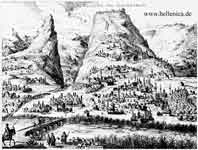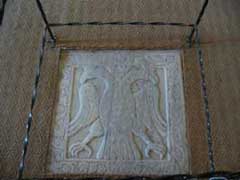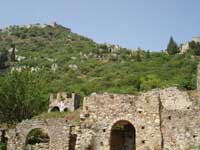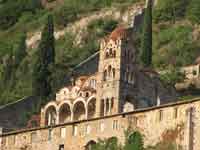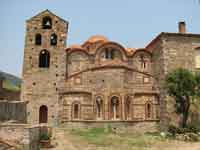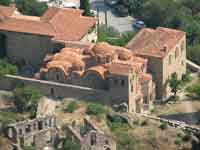.


Administrative Region : Peloponnese
Regional unit : Lakonia
Mystras (Greek: Μυστράς, Μυζηθράς, Myzithras in the Chronicle of the Morea) is a fortified town and a former municipality in Laconia, Peloponnese, Greece. Since the 2011 local government reform it is part of the municipality Sparti, of which it is a municipal unit.[1] Situated on Mt. Taygetos, near ancient Sparta, it served as the capital of the Byzantine Despotate of the Morea in the 14th and 15th centuries, experiencing a period of prosperity and cultural flowering. The site remained inhabited throughout the Ottoman period, when it was mistaken by Western travellers for ancient Sparta. In the 1830s, it was abandoned and the new town of Sparti was built, approximately eight kilometres to the east.
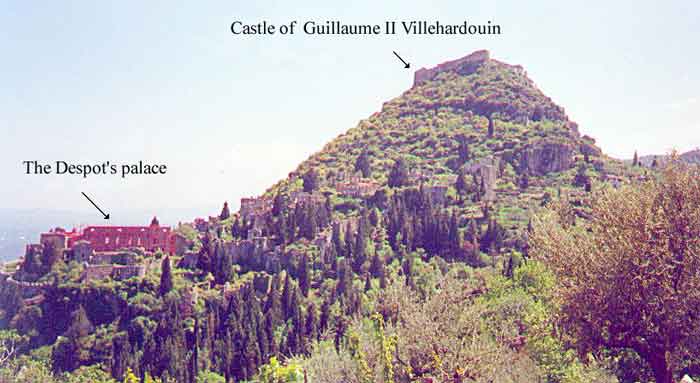
Castle of Guillaume II Villehardouin and Despot's palace [Source]
History
In 1249, Mystras became the seat of the Latin Principality of Achaea, established in 1205 after the conquest of Constantinople during the Fourth Crusade, and Prince William II Villehardouin, a grand-nephew of the Fourth Crusade historian Geoffrey of Villehardouin, built a palace there.
In 1261, the Latins ceded Mystras and other forts in the southeastern Peloponnese as ransom for William II, who had been captured in Pelagonia, and Michael VIII Palaeologus made the city the seat of the new Despotate of the Morea. It remained the capital of the despotate, ruled by relatives of the Byzantine emperor, although the Venetians still controlled the coast and the islands. Mystras and the rest of Morea became relatively prosperous after 1261, compared to the rest of the empire. Under the despot Theodore it became the second most important city in the empire after Constantinople, and William II's palace became the second residence of the emperors.
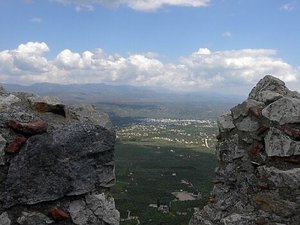
The Vale of Laconia seen from the battlements of Mystras
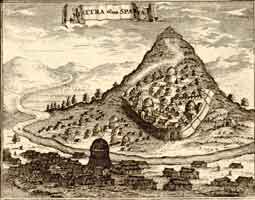
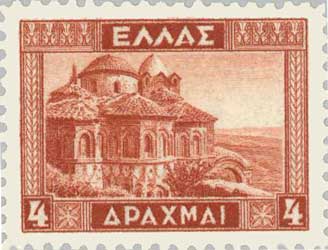
Pantanassa Monastery

Pantanassa Church, Lazarus Resurrection
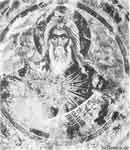
Zachariah, Mystras
The frescos in the Peribleptos Church, dating between 1348 and 1380, are a very rare surviving late Byzantine cycle, crucial for the understanding of Byzantine art.
Mystras was also the last centre of Byzantine scholarship; the Neoplatonist philosopher George Gemistos Plethon lived there until his death in 1452. He and other scholars based in Mystras influenced the Italian Renaissance, especially after he accompanied the emperor John VIII Palaiologos to Florence in 1439.
The last Byzantine emperor, Constantine XI Palaiologos, was despot at Mystras before he came to the throne. Demetrius Palaeologus the last despot of Morea, surrendered the city to the Ottoman emperor Mehmed II in 1460. As Mezistre, it was the seat of a Turkish sanjak. The Venetians occupied it from 1687 to 1715, but otherwise the Ottomans held it until 1821 and the beginning of the Greek War of Independence. It was abandoned by King Otto for the newly rebuilt Sparti.
In 1989 the ruins, including the fortress, palace, churches, and monasteries, were named a UNESCO World Heritage Site.
Click image to enlarge
Geography and statistics
Subdivisions
Division of the municipality of Mystras
- Magoula / Δ.δ. Μαγούλας [ 1.675 ]
- Magoula / η Μαγούλα [ 1.475 ]
- Sanatorio / το Σανατόριο [ 200 ]
- Magoula / η Μαγούλα [ 1.475 ]
- Agia Eirini / Δ.δ. Αγίας Ειρήνης -- η Αγία Ειρήνη [ 194 ]
- Agios Ioannis / Δ.δ. Αγίου Ιωάννου Λακεδαίμονος -- ο Άγιος Ιωάννης [ 699 ]
- Anavryti / Δ.δ. Αναβρυτής [ 92 ]
- Sanatorio / / η Αναβρυτή [ 91 ]
- Moni Faneromenis / η Μονή Φανερωμένης [ 1 ]
- Sanatorio / / η Αναβρυτή [ 91 ]
- Logastra / Δ.δ. Λογγάστρας [ 373 ]
- Logastra / η Λογγάστρα [ 294 ]
- Karavas / ο Καραβάς (Δ.δ. Λογγάστρας) [ 79 ]
- Logastra / η Λογγάστρα [ 294 ]
- Mystras / Δ.δ. Μυστρά [ 807 ]
- Mystras / ο Μυστράς [ 485 ]
- Vlachochorion / το Βλαχοχώριον [ 5 ]
- Palaiologio / το Παλαιολόγιο (τ. η Σκλαβική) [ 227 ]
- Pikoulianika / τα Πικουλιάνικα [ 75 ]
- Taygeti / η Ταϋγέτη [ 15 ]
- Mystras / ο Μυστράς [ 485 ]
- Paroreion / Δ.δ. Παρορείου -- το Παρόρειον [ 321 ]
- Soustianoi / Δ.δ. Σουστιάνων [ 180 ]
- Soustianoi / οι Σουστιάνοι [ 94 ]
- Karavas / ο Καραβάς (Δ.δ. Σουστιάνων) [ 86 ]
- Soustianoi / οι Σουστιάνοι [ 94 ]
- Trypi / Δ.δ. Τρύπης [ 267 ]
- Trypi / η Τρύπη [ 215 ]
- Karavas / ο Καραβάς (Δ.δ. Τρύπης) [ 29 ]
- Stavros / ο Σταυρός [ 23 ]
- Karavas / ο Καραβάς (Δ.δ. Τρύπης) [ 29 ]
The municipality seat of Mystras is in Magoula.
Historical population
Year Municipal district Municipality
1981 920 -
1991 525 4,592
2001 807 4,608
Notable people
People from Mystras
Gemistus Pletho (usually called Plethon) (1355-1452), philosopher and scholar
Burials
John VI Kantakouzenos
Manuel Kantakouzenos
Gemistus Pletho
Theodora Tocco
Cleofe Malatesta
Plan
Plan of Mystras after works by G. Millet (1910) and M. Chatzidakis (1981).
1. Main entrance;
2. Metropolis;
3. Evangelistria;
4. Saint-Theodores;
5. Hodigitria-Afendiko;
6. Monemvasia's Gate;
7. Saint-Nicolas;
8. The Despot's Palace and the square;
9. Nauplia's Gate;
10. Upper entrance to the citadel;
11. Saint-Sophia;
12. Small Palace;
13. Citadel;
14. Mavroporta;
15. Pantanassa;
16. Taxiarchs;
17. Frangopoulos' House;
18. Peribleptos;
19. Saint-Georges;
20. Krevata House;
21. Marmara (entrance);
22. Aï-Yannakids;
23. Laskaris' House;
24. Saint-Christopher;
25. Ruins;
26. Saint-Kyriaki.
References
Citations
^ Kallikratis law Greece Ministry of Interior (Greek)
Other sources
Runciman, Sir Steven (1980), Mistra: Byzantine Capital of the Peloponnese (2009 reprint: The Lost Capital of Byzantium: The History of Mistra and the Peloponnese; New foreword by John Freely.)
Films
Romer, John (1997), Byzantium: The Lost Empire; ABTV/Ibis Films/The Learning Channel; 4 episodes; 209 minutes. (In Episode 4 ["Forever and Ever"], presenter Romer devotes a section to strolling through Mistra evoking its glory in the days of Plethon.)
| Ancient Greece
Science, Technology , Medicine , Warfare, , Biographies , Life , Cities/Places/Maps , Arts , Literature , Philosophy ,Olympics, Mythology , History , Images Medieval Greece / Byzantine Empire Science, Technology, Arts, , Warfare , Literature, Biographies, Icons, History Modern Greece Cities, Islands, Regions, Fauna/Flora ,Biographies , History , Warfare, Science/Technology, Literature, Music , Arts , Film/Actors , Sport , Fashion --- |
Retrieved from "http://en.wikipedia.org/"
All text is available under the terms of the GNU Free Documentation License


